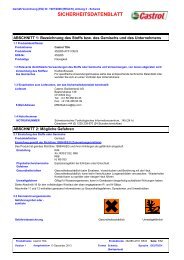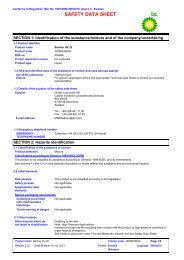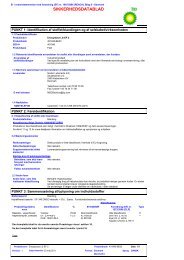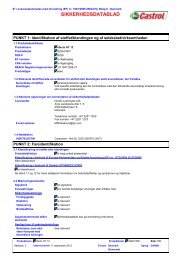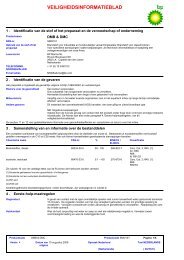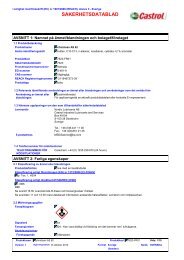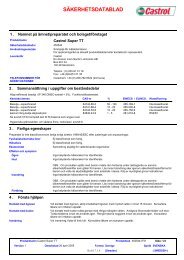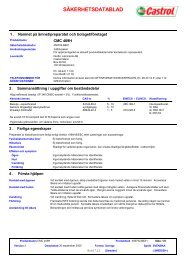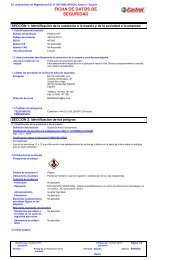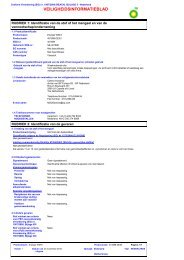(English (GB)) - BP - PDS & MSDS Search
(English (GB)) - BP - PDS & MSDS Search
(English (GB)) - BP - PDS & MSDS Search
Create successful ePaper yourself
Turn your PDF publications into a flip-book with our unique Google optimized e-Paper software.
Section 1. Identification<br />
GHS product identifier<br />
Product code<br />
SDS no.<br />
Use of the<br />
substance/preparation<br />
Manufacturer<br />
SAFETY DATA SHEET<br />
BioTac OG<br />
466244-<strong>GB</strong>09<br />
BioTac OG<br />
Supplier <strong>BP</strong>-Castrol(Thailand) Limited<br />
Samut Sakon Industrial Estate, 39/77-78 Moo 2 Rama II Road,<br />
Bangkachao Amphur Muang, Samut Sakorn 74000<br />
Tel. +66 34 419666, Fax. +66 34 419666<br />
EMERGENCY TELEPHONE<br />
NUMBER<br />
OTHER PRODUCT<br />
INFORMATION<br />
Section 2. Hazards identification<br />
GHS Classification<br />
GHS label elements<br />
466244<br />
Gear lubricant<br />
For specific application advice see appropriate Technical Data Sheet or consult our<br />
company representative.<br />
Carechem: 001800 1 2066 6751 (toll-free, access from Thailand only)<br />
Please contact at Technical Service Section<br />
Tel no.+ 662-684-3555<br />
SKIN CORROSION/IRRITATION - Category 2<br />
SERIOUS EYE DAMAGE/ EYE IRRITATION - Category 1<br />
Signal word Danger<br />
Hazard statements Causes skin irritation.<br />
Causes serious eye damage.<br />
Precautionary statements<br />
Prevention Wear protective gloves. Wear eye/face protection. Wash thoroughly after handling.<br />
Response Immediately call a POISON CENTER or doctor/physician. IF ON SKIN: Take off<br />
contaminated clothing and wash before re-use. Wash with plenty of soap and water.<br />
If skin irritation occurs, seek medical advice/attention. IF IN EYES: Rinse cautiously<br />
with water for several minutes. Remove contact lenses, if present and easy to do.<br />
Continue rinsing.<br />
Storage Not applicable.<br />
Disposal Not applicable.<br />
Symbol<br />
Product name BioTac OG<br />
Product code<br />
466244-<strong>GB</strong>09<br />
Page: 1/8<br />
Version 1<br />
Date of issue 23/11/2010<br />
Format GHS - Thailand Language ENGLISH<br />
Build 1.0.4<br />
(GHS - Thailand)<br />
(ENGLISH)
Section 3. Composition/information on ingredients<br />
Substance/mixture Mixture<br />
Soap. Proprietary performance additives.<br />
Ingredient name %<br />
CAS number<br />
calcium hydroxide 5 - 10 1305-62-0<br />
There are no additional ingredients present which, within the current knowledge of the supplier and in the<br />
concentrations applicable, are classified as hazardous to health or the environment and hence require<br />
reporting in this section.<br />
Occupational exposure limits, if available, are listed in section 8.<br />
Section 4. First-aid measures<br />
Description of necessary first aid measures<br />
Inhalation<br />
Get medical attention immediately. Move exposed person to fresh air. If it is<br />
suspected that fumes are still present, the rescuer should wear an appropriate mask<br />
or self-contained breathing apparatus. Keep person warm and at rest. If not<br />
breathing, if breathing is irregular or if respiratory arrest occurs, provide artificial<br />
respiration or oxygen by trained personnel. It may be dangerous to the person<br />
providing aid to give mouth-to-mouth resuscitation. If unconscious, place in recovery<br />
position and get medical attention immediately. Maintain an open airway. Loosen<br />
tight clothing such as a collar, tie, belt or waistband.<br />
Ingestion<br />
Skin contact<br />
Eye contact<br />
Get medical attention immediately. Wash out mouth with water. Remove dentures if<br />
any. Move exposed person to fresh air. Keep person warm and at rest. If material<br />
has been swallowed and the exposed person is conscious, give small quantities of<br />
water to drink. Stop if the exposed person feels sick as vomiting may be dangerous.<br />
Do not induce vomiting unless directed to do so by medical personnel. If vomiting<br />
occurs, the head should be kept low so that vomit does not enter the lungs.<br />
Chemical burns must be treated promptly by a physician. Never give anything by<br />
mouth to an unconscious person. If unconscious, place in recovery position and get<br />
medical attention immediately. Maintain an open airway. Loosen tight clothing such<br />
as a collar, tie, belt or waistband.<br />
Get medical attention immediately. Flush contaminated skin with plenty of water.<br />
Remove contaminated clothing and shoes. Wash contaminated clothing thoroughly<br />
with water before removing it, or wear gloves. Continue to rinse for at least 10<br />
minutes. Chemical burns must be treated promptly by a physician. Wash clothing<br />
before reuse. Clean shoes thoroughly before reuse.<br />
Get medical attention immediately. Immediately flush eyes with plenty of water,<br />
occasionally lifting the upper and lower eyelids. Check for and remove any contact<br />
lenses. Continue to rinse for at least 10 minutes. Chemical burns must be treated<br />
promptly by a physician.<br />
Indication of immediate medical attention and special treatment needed, if necessary<br />
Specific treatments Not available.<br />
Notes to physician Treatment should in general be symptomatic and directed to relieving any effects.<br />
Note: High Pressure Applications<br />
Injections through the skin resulting from contact with the product at high pressure<br />
constitute a major medical emergency. Injuries may not appear serious at first but<br />
within a few hours tissue becomes swollen, discoloured and extremely painful with<br />
extensive subcutaneous necrosis.<br />
Surgical exploration should be undertaken without delay. Thorough and extensive<br />
debridement of the wound and underlying tissue is necessary to minimise tissue loss<br />
and prevent or limit permanent damage. Note that high pressure may force the<br />
product considerable distances along tissue planes.<br />
Product name BioTac OG<br />
Product code<br />
466244-<strong>GB</strong>09<br />
Page: 2/8<br />
Version 1<br />
Date of issue 23/11/2010<br />
Format GHS - Thailand Language ENGLISH<br />
Build 1.0.4<br />
(GHS - Thailand)<br />
(ENGLISH)
Section 4. First-aid measures<br />
Protection of first-aiders No action shall be taken involving any personal risk or without suitable training. If it<br />
is suspected that fumes are still present, the rescuer should wear an appropriate<br />
mask or self-contained breathing apparatus. It may be dangerous to the person<br />
providing aid to give mouth-to-mouth resuscitation. Wash contaminated clothing<br />
thoroughly with water before removing it, or wear gloves.<br />
Section 5. Fire-fighting measures<br />
Extinguishing media<br />
Suitable<br />
Not suitable<br />
Specific hazards arising<br />
from the chemical<br />
Hazardous thermal<br />
decomposition products<br />
Special precautions for firefighters<br />
Special protective<br />
equipment for fire-fighters<br />
Use an extinguishing agent suitable for the surrounding fire.<br />
Do not use water jet.<br />
In a fire or if heated, a pressure increase will occur and the container may burst.<br />
Decomposition products may include the following materials:<br />
metal oxide/oxides<br />
Section 6. Accidental release measures<br />
Personal precautions,<br />
protective equipment and<br />
emergency procedures<br />
Environmental precautions<br />
Large spill<br />
Promptly isolate the scene by removing all persons from the vicinity of the incident if<br />
there is a fire. No action shall be taken involving any personal risk or without suitable<br />
training.<br />
Fire-fighters should wear appropriate protective equipment and self-contained<br />
breathing apparatus (SCBA) with a full face-piece operated in positive pressure<br />
mode.<br />
No action shall be taken involving any personal risk or without suitable training.<br />
Evacuate surrounding areas. Keep unnecessary and unprotected personnel from<br />
entering. Do not touch or walk through spilt material. Do not breathe vapour or mist.<br />
Provide adequate ventilation. Wear appropriate respirator when ventilation is<br />
inadequate. Put on appropriate personal protective equipment (see section 8).<br />
Avoid dispersal of spilt material and runoff and contact with soil, waterways, drains<br />
and sewers. Inform the relevant authorities if the product has caused environmental<br />
pollution (sewers, waterways, soil or air).<br />
Methods and materials for containment and cleaning up<br />
Small spill<br />
Stop leak if without risk. Move containers from spill area. Dilute with water and mop<br />
up if water-soluble or absorb with an inert dry material and place in an appropriate<br />
waste disposal container. Dispose of via a licensed waste disposal contractor.<br />
Section 7. Handling and storage<br />
Precautions for safe<br />
handling<br />
Stop leak if without risk. Move containers from spill area. Approach the release<br />
from upwind. Prevent entry into sewers, water courses, basements or confined<br />
areas. Wash spillages into an effluent treatment plant or proceed as follows.<br />
Contain and collect spillage with non-combustible, absorbent material e.g. sand,<br />
earth, vermiculite or diatomaceous earth and place in container for disposal<br />
according to local regulations (see section 13). Dispose of via a licensed waste<br />
disposal contractor. Contaminated absorbent material may pose the same hazard<br />
as the spilt product. Note: see section 1 for emergency contact information and<br />
section 13 for waste disposal.<br />
Put on appropriate personal protective equipment (see section 8). Eating, drinking<br />
and smoking should be prohibited in areas where this material is handled, stored and<br />
processed. Workers should wash hands and face before eating, drinking and<br />
smoking. Do not get in eyes or on skin or clothing. Do not breathe vapour or mist.<br />
Do not ingest. If during normal use the material presents a respiratory hazard, use<br />
only with adequate ventilation or wear appropriate respirator. Keep in the original<br />
container or an approved alternative made from a compatible material, kept tightly<br />
closed when not in use. Empty containers retain product residue and can be<br />
Product name BioTac OG<br />
Product code<br />
466244-<strong>GB</strong>09<br />
Page: 3/8<br />
Version 1<br />
Date of issue 23/11/2010<br />
Format GHS - Thailand Language ENGLISH<br />
Build 1.0.4<br />
(GHS - Thailand)<br />
(ENGLISH)
Section 7. Handling and storage<br />
Conditions for safe storage<br />
hazardous. Do not reuse container.<br />
Store in accordance with local regulations. Keep container in a cool, well-ventilated<br />
area. Keep container tightly closed and sealed until ready for use. Containers that<br />
have been opened must be carefully resealed and kept upright to prevent leakage.<br />
Do not store in unlabelled containers. Use appropriate containment to avoid<br />
environmental contamination.<br />
Not suitable Prolonged exposure to elevated temperature<br />
Section 8. Exposure controls/personal protection<br />
Control parameters<br />
Ingredient name Exposure limits<br />
calcium hydroxide ACGIH TLV (United States).<br />
TWA: 5 mg/m³ 8 hour(s). Issued/Revised:<br />
9/1994<br />
Recommended monitoring<br />
procedures<br />
Appropriate engineering<br />
controls<br />
Environmental exposure<br />
controls<br />
Individual protection measures<br />
Hygiene measures<br />
Respiratory protection<br />
Hand protection<br />
Eye protection<br />
If this product contains ingredients with exposure limits, personal, workplace<br />
atmosphere or biological monitoring may be required to determine the effectiveness<br />
of the ventilation or other control measures and/or the necessity to use respiratory<br />
protective equipment.<br />
If user operations generate dust, fumes, gas, vapour or mist, use process<br />
enclosures, local exhaust ventilation or other engineering controls to keep worker<br />
exposure to airborne contaminants below any recommended or statutory limits.<br />
Emissions from ventilation or work process equipment should be checked to ensure<br />
they comply with the requirements of environmental protection legislation. In some<br />
cases, fume scrubbers, filters or engineering modifications to the process equipment<br />
will be necessary to reduce emissions to acceptable levels.<br />
Wash hands, forearms and face thoroughly after handling chemical products, before<br />
eating, smoking and using the lavatory and at the end of the working period.<br />
Appropriate techniques should be used to remove potentially contaminated clothing.<br />
Wash contaminated clothing before reusing. Ensure that eyewash stations and<br />
safety showers are close to the workstation location.<br />
Use a properly fitted, air-purifying or air-fed respirator complying with an approved<br />
standard if a risk assessment indicates this is necessary. Respirator selection must<br />
be based on known or anticipated exposure levels, the hazards of the product and<br />
the safe working limits of the selected respirator.<br />
Chemical-resistant, impervious gloves complying with an approved standard should<br />
be worn at all times when handling chemical products if a risk assessment indicates<br />
this is necessary.<br />
Do not get in eyes. Wear face shield. Chemical splash goggles.<br />
Skin protection Personal protective equipment for the body should be selected based on the task<br />
being performed and the risks involved and should be approved by a specialist<br />
before handling this product.<br />
Section 9. Physical and chemical properties<br />
General information<br />
Appearance<br />
Physical state<br />
Grease<br />
Colour Beige.<br />
Odour Characteristic.<br />
Important health, safety and environmental information<br />
Product name BioTac OG<br />
Product code<br />
466244-<strong>GB</strong>09<br />
Page: 4/8<br />
Version 1<br />
Date of issue 23/11/2010<br />
Format GHS - Thailand Language ENGLISH<br />
Build 1.0.4<br />
(GHS - Thailand)<br />
(ENGLISH)
Section 9. Physical and chemical properties<br />
Flash point Closed cup: >230°C (>446°F) [Pensky-Martens.]<br />
Auto-ignition temperature Not available.<br />
Explosive properties<br />
Decomposition temperature<br />
Vapour pressure<br />
Not available.<br />
Explosion limits Not available.<br />
Flammability (solid, gas) Not available.<br />
Not available.<br />
Not available.<br />
Vapour density Not available.<br />
Volatility Not available.<br />
Evaporation rate<br />
Density<br />
Not available.<br />
Critical temperature Not available.<br />
Oxidising properties Not available.<br />
Odour threshold Not available.<br />
Viscosity Not available.<br />
pH Not available.<br />
Boiling point / range<br />
Melting point / range<br />
Not available.<br />
Not available.<br />
Drop Point Not available.<br />
Relative Density Not available.<br />
1210 kg/m 3 (1.21 g/cm 3 ) at 20°C<br />
Solubility insoluble in water.<br />
Solubility at room<br />
temperature (g/l)<br />
Dispersibility properties Not available.<br />
Partition coefficient<br />
(LogKow)<br />
Not available.<br />
Not available.<br />
Section 10. Stability and reactivity<br />
Chemical stability<br />
Possibility of hazardous<br />
reactions<br />
Conditions to avoid<br />
Incompatible materials<br />
Hazardous decomposition<br />
products<br />
The product is stable.<br />
Under normal conditions of storage and use, hazardous reactions will not occur.<br />
Avoid all possible sources of ignition (spark or flame).<br />
No specific data.<br />
Section 11. Toxicological information<br />
Under normal conditions of storage and use, hazardous decomposition products<br />
should not be produced.<br />
Information on the likely routes of exposure<br />
Inhalation May give off gas, vapor or dust that is very irritating or corrosive to the respiratory<br />
system.<br />
May cause burns to mouth, throat and stomach.<br />
Ingestion<br />
Skin contact Causes skin irritation.<br />
Eye contact<br />
Causes serious eye damage.<br />
Symptoms related to the physical, chemical and toxicological characteristics<br />
Inhalation No specific data.<br />
Ingestion<br />
Adverse symptoms may include the following:<br />
stomach pains<br />
Product name BioTac OG<br />
Product code<br />
466244-<strong>GB</strong>09<br />
Page: 5/8<br />
Version 1<br />
Date of issue 23/11/2010<br />
Format GHS - Thailand Language ENGLISH<br />
Build 1.0.4<br />
(GHS - Thailand)<br />
(ENGLISH)
Section 11. Toxicological information<br />
Skin Adverse symptoms may include the following:<br />
pain or irritation<br />
redness<br />
blistering may occur<br />
Eyes Adverse symptoms may include the following:<br />
pain<br />
watering<br />
redness<br />
Delayed and immediate effects and also chronic effects from short and long term exposure<br />
Other information Unlikely to cause more than transient stinging or redness if accidental eye contact<br />
occurs.<br />
Unlikely to cause harm to the skin on brief or occasional contact but prolonged or<br />
repeated exposure may lead to dermatitis.<br />
Unlikely to cause harm if accidentally swallowed in small doses, though larger<br />
quantities may cause nausea and diarrhoea.<br />
At normal ambient temperatures this product will be unlikely to present an inhalation<br />
hazard because of its low volatility. May be harmful by inhalation if exposure to<br />
vapour, mists or fumes resulting from thermal decomposition products occurs.<br />
Potential chronic health effects<br />
General<br />
No known significant effects or critical hazards.<br />
Inhalation No known significant effects or critical hazards.<br />
Ingestion<br />
No known significant effects or critical hazards.<br />
Skin contact No known significant effects or critical hazards.<br />
Eye contact<br />
No known significant effects or critical hazards.<br />
Carcinogenicity<br />
No known significant effects or critical hazards.<br />
Mutagenicity<br />
No known significant effects or critical hazards.<br />
Teratogenicity<br />
No known significant effects or critical hazards.<br />
Developmental effects No known significant effects or critical hazards.<br />
Fertility effects No known significant effects or critical hazards.<br />
Other information Not available.<br />
Section 12. Ecological information<br />
Environmental effects No known significant effects or critical hazards.<br />
Persistence/degradability Inherently biodegradable<br />
Mobility Spillages are unlikely to penetrate the soil.<br />
Bioaccumulative potential<br />
This product is not expected to bioaccumulate through food chains in the<br />
environment.<br />
Other adverse effects No known significant effects or critical hazards.<br />
Other ecological information This product is unlikely to disperse in water.<br />
Product name BioTac OG<br />
Product code<br />
466244-<strong>GB</strong>09<br />
Page: 6/8<br />
Version 1<br />
Date of issue 23/11/2010<br />
Format GHS - Thailand Language ENGLISH<br />
Build 1.0.4<br />
(GHS - Thailand)<br />
(ENGLISH)
Section 13. Disposal considerations<br />
Disposal methods<br />
Section 14. Transport information<br />
Regulatory<br />
information<br />
IATA Class<br />
IMDG Class<br />
PG* : Packing group<br />
The generation of waste should be avoided or minimised wherever possible. Empty<br />
containers or liners may retain some product residues. This material and its<br />
container must be disposed of in a safe way. Dispose of surplus and non-recyclable<br />
products via a licensed waste disposal contractor. Disposal of this product, solutions<br />
and any by-products should at all times comply with the requirements of<br />
environmental protection and waste disposal legislation and any regional local<br />
authority requirements. Avoid dispersal of spilt material and runoff and contact with<br />
soil, waterways, drains and sewers.<br />
UN number Proper shipping<br />
name<br />
Not<br />
regulated.<br />
Not<br />
regulated.<br />
Section 15. Regulatory information<br />
Regulation according to other foreign laws<br />
Europe inventory<br />
United States inventory<br />
(TSCA 8b)<br />
Australia inventory (AICS)<br />
Canada inventory status<br />
China inventory (IECSC)<br />
Japan inventory (ENCS)<br />
Korea inventory (KECI)<br />
Philippines inventory<br />
(PICCS)<br />
Hazardous Substance Act B.E. 2535 (1992)<br />
Type<br />
Classes<br />
PG* Label Additional<br />
information<br />
- - - -<br />
- - - -<br />
All components are listed or exempted.<br />
All components are listed or exempted.<br />
At least one component is not listed.<br />
All components are listed or exempted.<br />
All components are listed or exempted.<br />
All components are listed or exempted.<br />
All components are listed or exempted.<br />
At least one component is not listed.<br />
Ingredient name Type Authority Conditions<br />
Acetic acid. 3<br />
Department of Products used for<br />
Fisheries<br />
fisheries and<br />
aquaculture for control,<br />
prevention and<br />
elimination of bacteria,<br />
parasites and animals<br />
3<br />
-<br />
Harmful Chemicals List I Listed<br />
Department of<br />
Industrial Works<br />
Product name BioTac OG<br />
Product code<br />
466244-<strong>GB</strong>09<br />
Page: 7/8<br />
Version 1<br />
Date of issue 23/11/2010<br />
Format GHS - Thailand Language ENGLISH<br />
Build 1.0.4<br />
(GHS - Thailand)<br />
(ENGLISH)
Section 16. Other information<br />
History<br />
Date of issue/Date of<br />
revision<br />
Date of previous issue<br />
Prepared by<br />
23/11/2010.<br />
No previous validation.<br />
Product Stewardship<br />
Indicates information that has changed from previously issued version.<br />
Notice to reader<br />
All reasonably practicable steps have been taken to ensure this data sheet and the health, safety and environmental<br />
information contained in it is accurate as of the date specified below. No warranty or representation, express or implied<br />
is made as to the accuracy or completeness of the data and information in this data sheet.<br />
The data and advice given apply when the product is sold for the stated application or applications. You should not use<br />
the product other than for the stated application or applications without seeking advice from us.<br />
It is the user’s obligation to evaluate and use this product safely and to comply with al applicable laws and regulations.<br />
The <strong>BP</strong> Group shall not be responsible for any damage or injury resulting from use, other than the stated product use of<br />
the material, from any failure to adhere to recommendations, or from any hazards inherent in the nature of the material.<br />
Purchasers of the product for supply to a third party for use at work, have a duty to take all necessary steps to ensure<br />
that any person handling or using the product is provided with the information in this sheet. Employers have a duty to<br />
tell employees and others who may be affected of any hazards described in this sheet and of any precautions that<br />
should be taken.<br />
Product name BioTac OG<br />
Product code<br />
466244-<strong>GB</strong>09<br />
Page: 8/8<br />
Version 1<br />
Date of issue 23/11/2010<br />
Format GHS - Thailand Language ENGLISH<br />
Build 1.0.4<br />
(GHS - Thailand)<br />
(ENGLISH)



